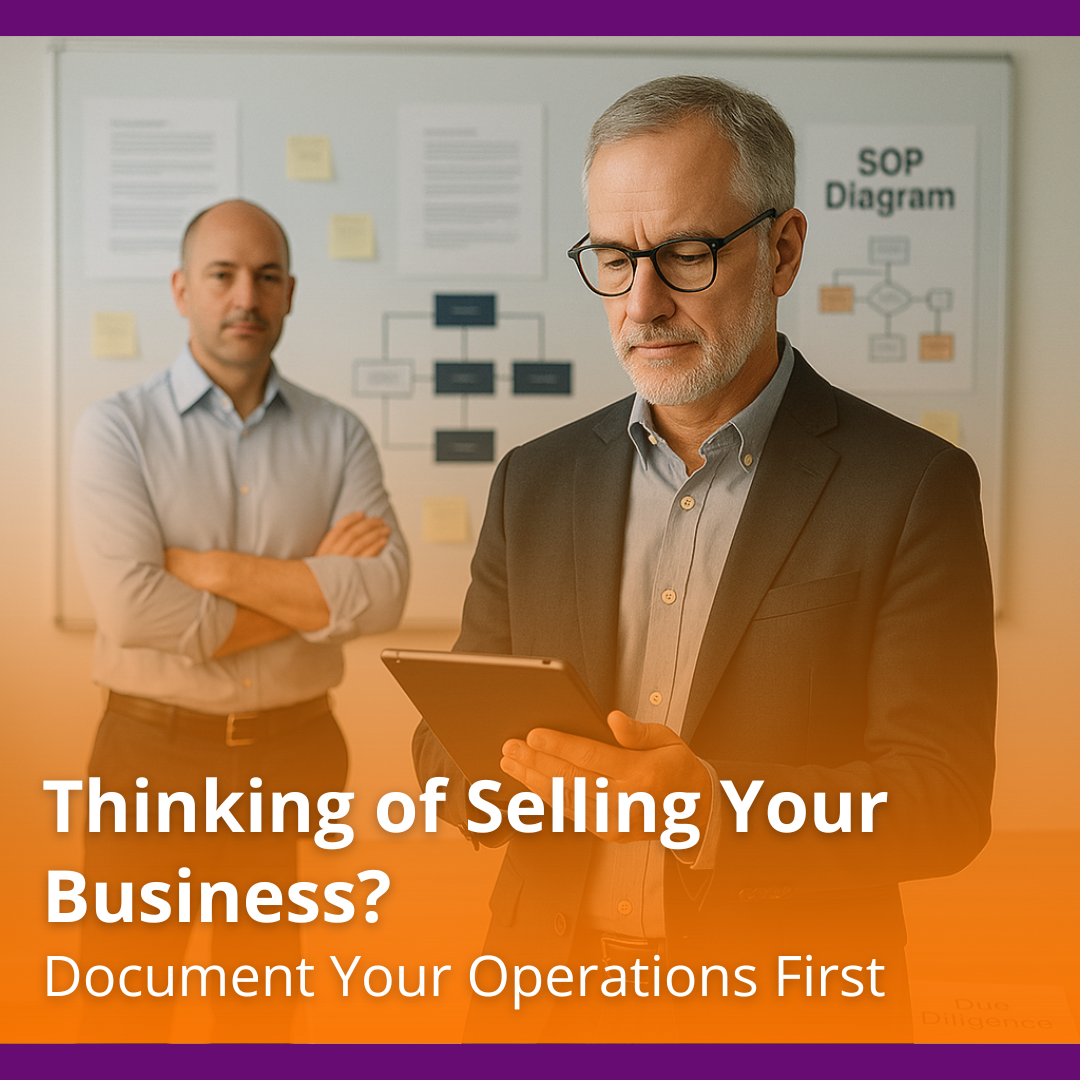Thinking of Selling Your Business? Document Your Operations First
Running a business means knowing every moving part. But to a buyer, that knowledge means nothing if it isn’t documented. And that’s a...
Comprehensive, data-driven valuations and comparative equity analyses to accurately price your practice, establish market benchmarks, and support informed decision-making.
Comprehensive M&A guidance encompassing deal structuring, negotiation strategies, market listings, and transaction closings.
Comprehensive systems, targeted coaching, and in-depth assessments designed to optimize operational efficiency and enhance advisory team effectiveness.
Strengthen continuity through the implementation of formal continuity agreements, the establishment of legal entities, execution of enforceable legal contracts, and securing appropriate capital resources.
4 min read
 Anthony Whitbeck, CFP®, CLU®
June 30, 2025
Anthony Whitbeck, CFP®, CLU®
June 30, 2025

If 2024 was a year of caution and 2025 was a year of realignment, 2026 is poised to be the year of acceleration.
As we close out 2025, the data paints a clear picture: the "wait-and-see" era is ending. According to recent investment outlooks from Morgan Stanley, global M&A activity is projected to see robust volume growth of nearly 20% in 2026. The drivers have shifted from simple survival to strategic dominance—buyers are no longer just looking for assets; they are hunting for capabilities.
In December 2025, the financial services sector is witnessing a release of pent-up demand. Private equity firms, sitting on record levels of deployable capital, are under immense pressure to exit vintage investments and deploy cash. For financial advisors and RIAs, this means the window for high-value exits is opening wider, but the criteria for a "premium valuation" have fundamentally changed.
This article breaks down the acceleration of the market, the rise of the "AI Premium," and how firms must adapt their strategy to win in the 2026 M&A environment.
The 2026 M&A environment reflects a market that has normalized to a higher rate environment and is now ready to run. Uncertainty hasn't disappeared, but dealmakers have learned to navigate it. The focus has turned from "stabilizing the ship" to "upgrading the engine."
The defining characteristic of the 2026 market is the resurgence of the "buy and build" strategy. Rather than opportunistic, one-off acquisitions, buyers are executing thematic roll-ups designed to create massive economies of scale. We are seeing a 19% year-over-year increase in strategic platform deals, where the goal isn't just AUM growth, but the integration of proprietary technology stacks that can service clients more efficiently.
The United States continues to be the engine of global M&A. Heading into 2026, U.S. transactions are expected to outperform global peers, driven by a resilient domestic economy and a pro-growth policy environment. Inbound interest from European and Asian buyers remains high, as international capital seeks the stability and tech-leadership of the U.S. wealth management sector.
Perhaps the most significant shift for 2026 is the valuation premium being assigned to firms with "AI Readiness." Buyers are no longer just asking about EBITDA; they are asking about data hygiene and digital client acquisition. According to Gartner's Top Strategic Technology Trends for 2026, firms that successfully embed "Agentic AI" into their workflows—reducing operational overhead and boosting advisor capacity—are commanding multiples significantly higher than their analog peers.
Several powerful forces are converging to define the landscape for financial advisors this year.
The ticking clock for private equity has grown louder. With nearly $2.5 trillion in undeployed capital ("dry powder") globally, PE firms can no longer afford to sit on the sidelines. Moreover, many portfolios hold RIA investments from the 2020-2021 boom that are now ripe for exit. This creates a dual-sided market pressure: a rush to sell mature assets and a desperate need to buy new growth platforms. For advisors, this means a crowded, competitive field of well-capitalized buyers in 2026.
After years of acting as a brake on deal activity, interest rates are expected to become a tailwind in 2026. With the Federal Reserve signaling a stabilizing rate environment, the cost of acquisition capital is becoming more predictable. This stability allows buyers to model deals with greater confidence, narrowing the bid-ask spread that stifled so many transactions in 2024 and early 2025.
The "Great Valuation Reset" of 2025 has settled into a new reality: Bifurcation. The median multiple has stabilized, but the spread between "average" firms and "quality" firms has widened. High-quality firms—those with next-gen talent, organic growth >10%, and clean data—are seeing multiples rivaling the peaks of 2021. Average firms, however, are trading at a discount, penalized for aging client bases or lack of tech adoption.
In a major shift for 2026, buyers are prioritizing how firms grow. The old metric was "referral growth"; the new metric is "Digital Client Acquisition Cost (CAC)." Firms that have built scalable digital marketing engines that do not rely solely on advisor networking are viewed as more durable and scalable assets.
The "barbell" effect in the RIA space is accelerating. The market is hollowing out the middle. We are seeing intense activity for firms with $2 billion+ in AUM (platform targets) and firms with $200 million - $500 million (tuck-in targets). Firms stuck in the $500M - $1B range often face a "no man's land"—too big to be a simple tuck-in, but lacking the infrastructure to be a platform. For these firms, 2026 is the year to either buy (to reach scale) or sell (to join a platform).
In asset management M&A, the dominant theme is the acquisition of Private Credit capabilities. Traditional asset managers are aggressively buying private credit shops to meet investor demand for yield. This trend is reshaping the buyer universe, bringing large institutional asset managers into the RIA M&A space as they look for distribution channels for these alternative products.
The market dynamics of 2026 favor the prepared. Speed of execution will be a competitive advantage this year.
Getting your valuation right is just step one. In 2026, data integrity is part of your valuation. Buyers are conducting deeper due diligence on your tech stack and client data than ever before.
Action Item: Audit your CRM. Can you prove your organic growth sources? Is your client data "AI-ready"?
Strategic Fit: Don't just solve for price; solve for platform. If you sell to a PE-backed aggregator, understand their "exit clock." Are they selling in 3 years? Does that align with your timeline?
The "aggregators" of the past decade are becoming the "integrators" of 2026. Successful buyers this year will be those who have a proven "operating system" for acquired firms.
Action Item: Define your "Digital Edge." What technology do you bring to a seller that they can't build themselves?
Financing: With private credit markets robust, consider non-bank lending options that offer more flexibility for "buy and build" strategies than traditional bank debt.
The M&A market has shifted gears from "recovery" to "velocity." The opportunities in 2026 are significant, but the complexity of transactions has increased. The firms that win this year will be those that combine traditional relationship strength with modern operational readiness.
At Advisor Legacy, we help financial advisors navigate this accelerating landscape. Whether you need an objective Valuation to benchmark your firm against 2026 multiples or a Succession Plan that accounts for the new PE dynamics, we are your strategic partner.
Is your firm ready for the 2026 market? Start with our free assessment and receive a personalized coaching session from one of our M&A experts.
Anthony "Tony" Whitbeck, CFP®, CLU®, is CEO and Owner of Advisor Legacy. He began his career as a financial advisor in 1989 and later shifted to coaching, where he’s guided more than two hundred advisory practices through growth, valuation, and succession. Tony leads Advisor Legacy’s certified third-party valuation engagements and coordinates lending and legal partners to streamline transactions. His articles focus on building transferable enterprise value, mapping internal vs. external exits, and avoiding common succession pitfalls. Drawing on decades of in-the-trenches experience, Tony provides practical, compliance-friendly guidance advisors can use right away.
Receive timely articles, tip sheets, events, and more right in your inbox.

Running a business means knowing every moving part. But to a buyer, that knowledge means nothing if it isn’t documented. And that’s a...

Growing by acquisition is one of the fastest ways to scale — but it’s also one of the easiest ways to stumble. Behind every successful deal is a...

The M&A landscape in financial services isn’t slowing down. It’s evolving. Fast. As of mid-2025, deal values in the sector have surged by...